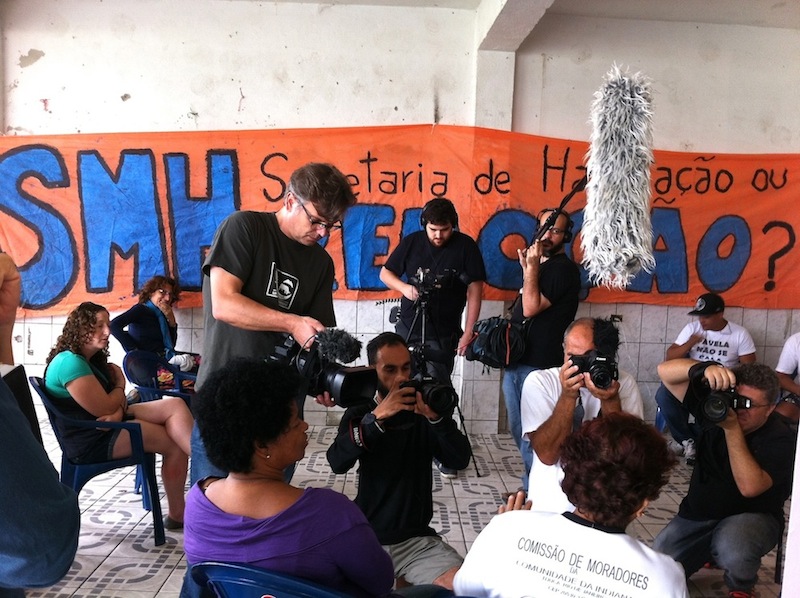 Last month in Providência Favela Não Se Cala organized a gathering of over fifty people that included residents of favelas from across the city, public defenders, law students, activists and social workers. Photographers and videographers flitted about the discussion circle, including the crew of Dominio Público, the investigative project currently being filmed about the privatization of Rio. Favela residents shared their experiences of state policy toward their communities and efforts to counter some of those policies, namely the displacement of thousands of families to public housing with low transparency and public works that often harm residents more than they benefit them.
Last month in Providência Favela Não Se Cala organized a gathering of over fifty people that included residents of favelas from across the city, public defenders, law students, activists and social workers. Photographers and videographers flitted about the discussion circle, including the crew of Dominio Público, the investigative project currently being filmed about the privatization of Rio. Favela residents shared their experiences of state policy toward their communities and efforts to counter some of those policies, namely the displacement of thousands of families to public housing with low transparency and public works that often harm residents more than they benefit them.
The Providência forum on Saturday May 19 was one in a stream of recent activities organized or attended by the group, which also held a meeting of over two hundred people in Horto last month and was present at the recent launch of the Popular Committee’s dossier and debate about public security in Maré.
The Providência meeting focused on specifics in a climate of developing awareness about what’s happening to Rio’s favela residents as the city prepares for the coming mega-events. In Providência, over a third of the homes (more than 600) have been removed or marked for removal under justification that residents either live in risk areas—a concept refuted at length by an engineer at the meeting—or that the removals are necessary for the execution of Morar Carioca, the municipal program stated to provide on-site upgrades to favelas.
Cable Car Denunciations
Forty-six percent of the money spent on Morar Carioca so far in Providência has gone toward the cable car currently under construction, which Mayor Eduardo Paes said will become “Sugarloaf Mountain number two.” At the meeting, Rio de Janeiro State University (UERJ) Social Services professor Isabel Costa Cardoso of the Port Community Forum talked about the three major impacts for residents receiving a cable car, having also spoken with residents in Complexo do Alemão where one has already been installed and Rocinha where one is planned: “The first point is the degree to which the installation of these cable cars is profitable to the same group of construction companies,” said Cardoso. She went on, “The second point is about the home removals and lack of public participation that are part of the cable car installation process.” Over half of the homes higher on the hill than the drop-off point of the cable car—supposedly, those residents who would stand to benefit most from its installation—live in homes marked for removal. Some homes have already been demolished, with their former residents either living in public housing units in the West Zone, receiving R$400 monthly social rent, building new homes in distant favelas on land purchased with compensations received, or staying with friends and family while they await or negotiate compensation payment for homes. The remainder of Morar Carioca construction in Providência is currently stalled due to a court ruling citing lack of fulfillment of public audience requirements before the construction began.
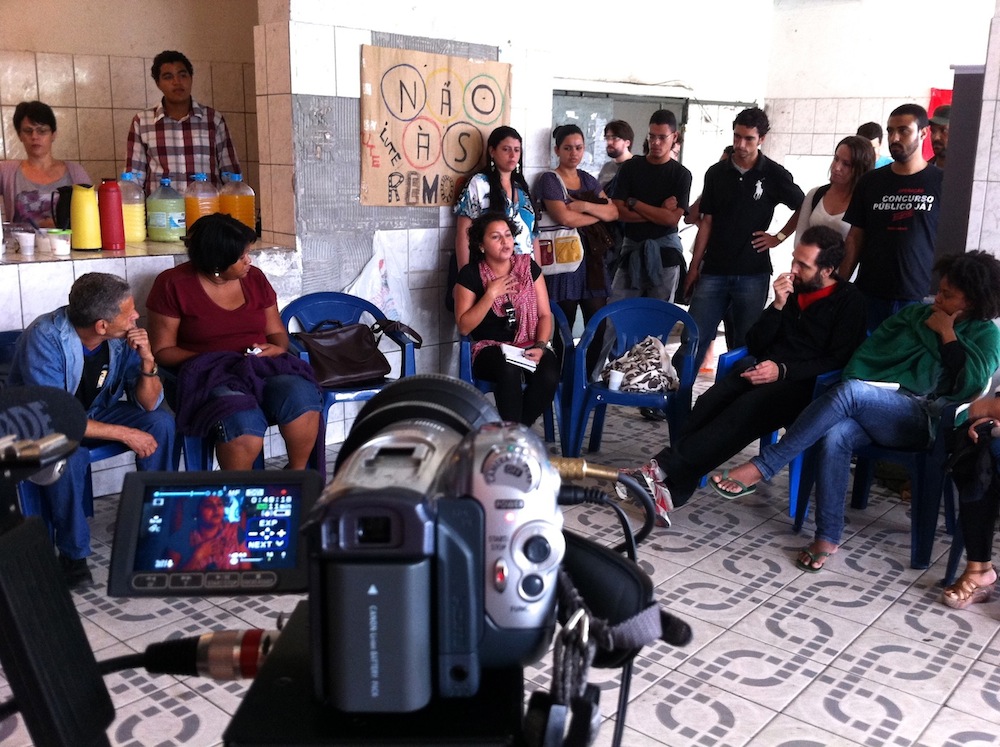 “Our third point to emphasize,” continued Cardoso, “is that although these cable cars have been talked up as methods for increasing access to transportation, never—not in local, state, or federal law—has a cable car been recommended as an effective method to increasing urban mobility.” Cardoso invited all who were interested to join in refining these points after the meeting and strategize for their dissemination to people inside and outside Providência.
“Our third point to emphasize,” continued Cardoso, “is that although these cable cars have been talked up as methods for increasing access to transportation, never—not in local, state, or federal law—has a cable car been recommended as an effective method to increasing urban mobility.” Cardoso invited all who were interested to join in refining these points after the meeting and strategize for their dissemination to people inside and outside Providência.
“My grandmother built her home in Providência without needing a cable car, without a mototaxi and without a kombi van,” said resident Cosme Felippsen. “She walked up.” Felippsen read out a poem he had written about the history of Providência, the first favela in Rio, including its founding by industrious soldiers returning from the Canudos war in 1897, the original installations of buildings and public spaces, and more recent phases of development such as the arrival of the LAN-houses, internet access points that proceeded today’s wi-fi.
Eron César dos Santos, a capoeira instructor from Providência, said he was glad there was historical research underway into Providência’s role in the birth of samba music. What made him less easy, he said, was seeing things like a restaurant guide to the favelas on sale in a fancy store for R$70. “We have to be careful with these things. Who is gaining with this promotion of culture?” dos Santos asked, saying that it was important for favela residents to maintain ownership of their identities and the legacy they were inheriting. “You don’t need to leave the favela to improve your life. You need to tell your story.”
Organizing to Prevent Evictions
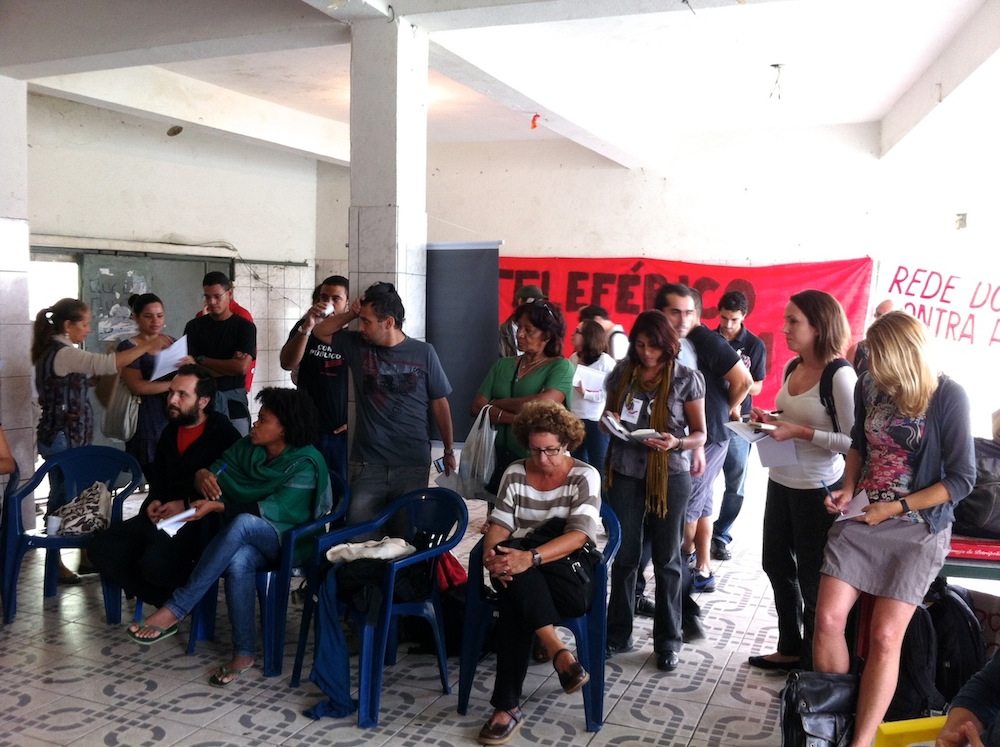 Maria do Socorro gave an update to the group on the story of her community, Indiana-Tijuca, which is representative both in the degree of transparency in which removals are being conducted and in the tactics that communities can use to counter them better.
Maria do Socorro gave an update to the group on the story of her community, Indiana-Tijuca, which is representative both in the degree of transparency in which removals are being conducted and in the tactics that communities can use to counter them better.
Do Socorro told the group that on January 17, 2012, she and other members of the Indiana-Tijuca Residents’ Association were called to a meeting with then-Municipal Housing Secretary Jorge Bittar, who said the community was going to receive public improvements. Two weeks later, every house in the community was spray-painted with the Housing Secretariat’s initials, SMH, sign that they were slated for demolition. As some families and homes were taken out, the community fought back. Then, on December 10, 2012, they received a judicial order suspending demolition because a 2006-2010 study was identified that said that in fact the community was in an area of low environmental risk. By that time, 110 families had already been removed to public housing in Triagem in Rio’s North Zone, almost an hour away by public transportation. 720 families remain. On May 16, the community began the process of legalization of land ownership.
Do Socorro said that although her community should serve as a success story of fighting for a community’s right to stay, they still faced one of the most common obstacles to exercising this right—unity. “We had a public hearing on May 9 with City Councilman Renato Cinco and Subsecretary of Housing Marco Antonio about evictions. I have to say, it was hectic, with fifty people asking for new units in public housing and fifty who wanted to stay where they were.” Do Socorro said that overall, the community has significant inertia, because 500 of the remaining families want to stay and 120 want to go. “Most people you ask will say, ‘for the love of God, don’t move me to Triagem.’” Do Socorro encouraged everyone present to clarify their own messages about what their communities wanted, and to utilitize resources such as the public defenders office and spread information about their case.
André Constantine, a resident of Babilônia, said that sometimes the reason not all communities are as successful as Indiana with this issue comes from a group within the community itself—the Residents Association. “In many cases, the residents association has been bought by the city government,” Constantine said, receiving special treatment in exchange for not protesting municipal actions toward the favela. Clientelism within the residents associations has been an issue in the democratic governance of favelas since the associations were required by law in the early 1960s by Rio de Janeiro State. Examples of this abound; on March 9 of this year, after Pavão-Pavãozinho resident Elisangela Sena had booked a plaza near her home days in advance, as was required, for a Favela Não Se Cala meeting, two hours ahead of time she learned that the Association was instead using the plaza for a city-sponsored event, leaving Favela Não Se Cala to scramble for a new space and try to spread word of the change to would-be attendees of the event by phone.
Constantine said because of these issues, it was especially important to stay organized and keep flows of information open about what is happening.
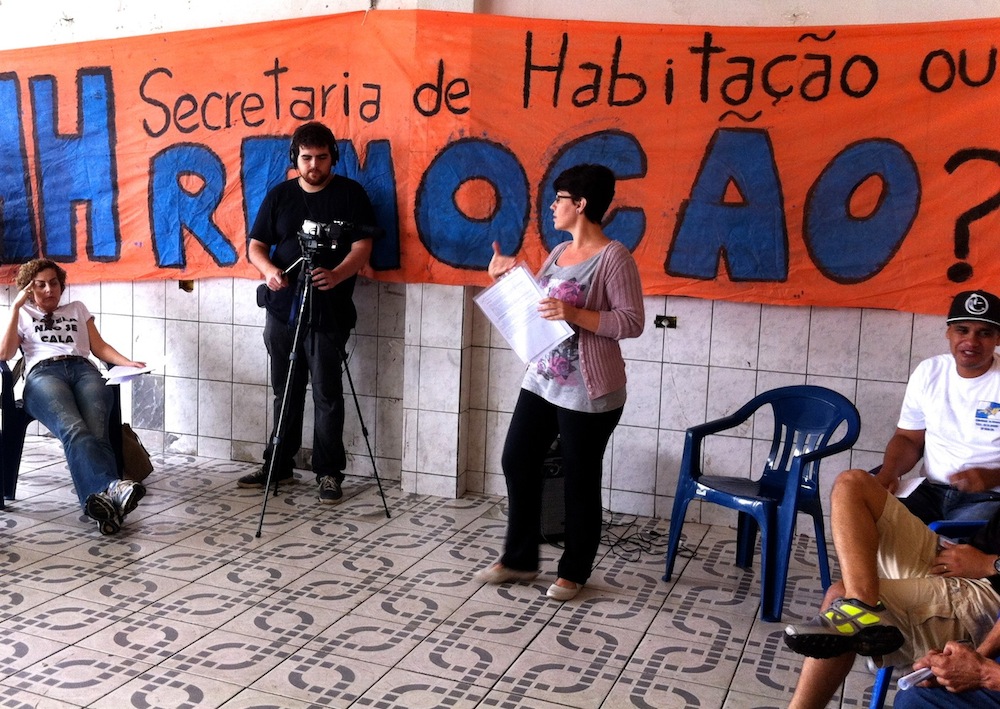 Inconsistencies With Blaming ‘Risk’
Inconsistencies With Blaming ‘Risk’
Civil and mechanical engineer Maurício Campos, who has worked for over fifteen years on slope stabilization projects, clarified a few things about the city’s common “environmental risk” justification for removing families from favelas. Campos has said in the past that the dramatic mudslides that occur in some favelas during rainy season are the result of lack of proper slope stabilization and drainage infrastructure, both public responsibilities, and that no favela actually needs to be entirely removed due to geographic risk.
“It is much less expensive to solve the environmental risk issue by actually providing these stabilization projects to the favelas than it is to remove them entirely,” Campos said. “Yet the city has announced that they are planning to do that to 122 favelas.” Inconsistencies with the environmental risk justification abound; one Borel community was removed because it was in a “risk area” only for R$600,000 apartments to be built on the same site.
Campos encouraged the group to consider the risk justification, outlined in a 2010 city publication, when they were adding up the total number of families being relocated across the city. “This week, I saw numbers around 8,000 being reported due to the Popular Committee report summarizing human rights violations in the run up to the coming mega-events. That number is far too low. The number of families who live in these supposed ‘high risk’ communities is 20,247. If you multiply them by around five members per family, you are looking at over 100,000 people being removed due to the risk justification alone.”
Campos pulled out a copy of the Morar Carioca guidelines. “Here in this document, which was signed into city decree in October 2012, there are instructions for the removal of anyone who lives in what the city has classified a risk area. Right there, that breaks the national law and the city law, which provide explicitly for the on-site upgrading of favelas.” Campos encouraged attendees to be aware of these laws, reprinted in a document distributed by the Port Community Forum.
Discussing Gentrification & Security
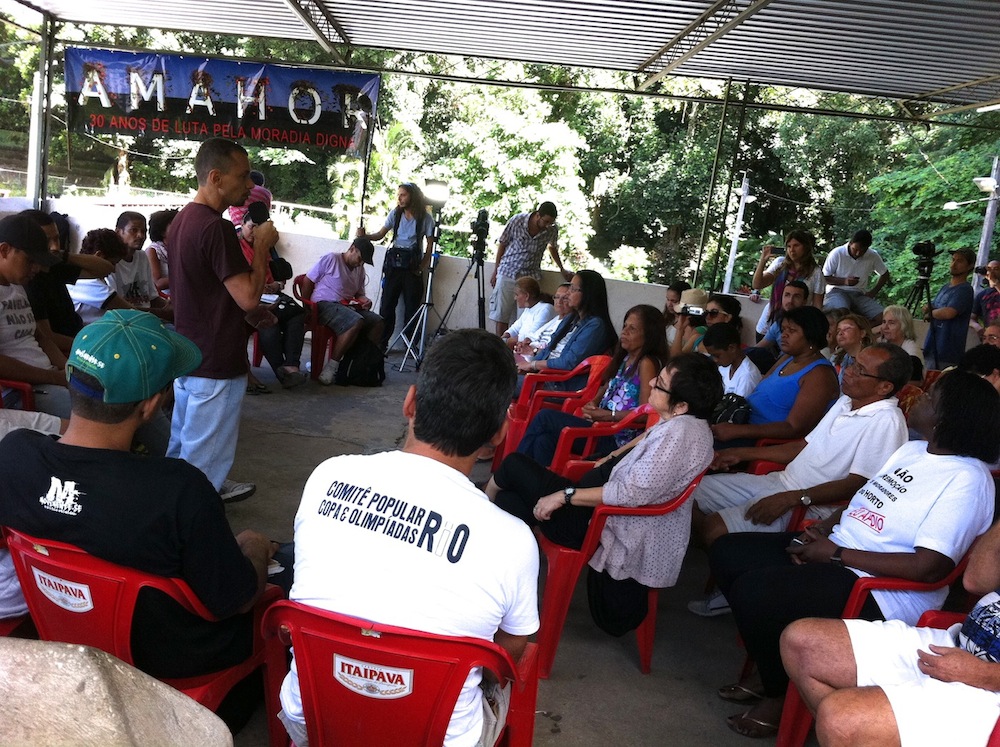 In April, Favela Não Se Cala also met in Horto, a well-organized community near the botanical gardens that is currently resisting removal. There were over 200 people in attendance, including representatives from almost all of the fourteen favelas who currently participate in Favela Não Se Cala—Providência, Cantagalo, Pavão-Pavãozinho, Borel, Babilônia, Chapéu Mangueira, Indiana-Tijuca, Santa Marta, Salgueiro, Manguinhos, Acari, Rocinha, Horto, and Jacarezinho. In addition, representatives spoke from the Pastoral das Favelas, Popular Committee of the World Cup and Olympics, the past and present State housing public defender’s office, and the law school of the Catholic University of Rio (PUC-Rio). Repper Fiel of Santa Marta, who raps about issues of favela identity, removals, and gentrification, performed at the close.
In April, Favela Não Se Cala also met in Horto, a well-organized community near the botanical gardens that is currently resisting removal. There were over 200 people in attendance, including representatives from almost all of the fourteen favelas who currently participate in Favela Não Se Cala—Providência, Cantagalo, Pavão-Pavãozinho, Borel, Babilônia, Chapéu Mangueira, Indiana-Tijuca, Santa Marta, Salgueiro, Manguinhos, Acari, Rocinha, Horto, and Jacarezinho. In addition, representatives spoke from the Pastoral das Favelas, Popular Committee of the World Cup and Olympics, the past and present State housing public defender’s office, and the law school of the Catholic University of Rio (PUC-Rio). Repper Fiel of Santa Marta, who raps about issues of favela identity, removals, and gentrification, performed at the close.
Several favela residents spoke about the pacification-commercialization cycle that has been increasingly pronounced in favelas and how it has brought price hikes in utilities that would be unjustifiably high even in the formal city. For favela residents, these price increases act as a strong pressure to drive them out, and since many were unaccustomed to receiving private utility bills, instead paying to the residents association or another body for provision, they did not know what normal prices were and so did not know whether to protest. One woman from Salgueiro cited a monthly electricity bill of R$350 (US$175) for having one television and one refrigerator in her house.
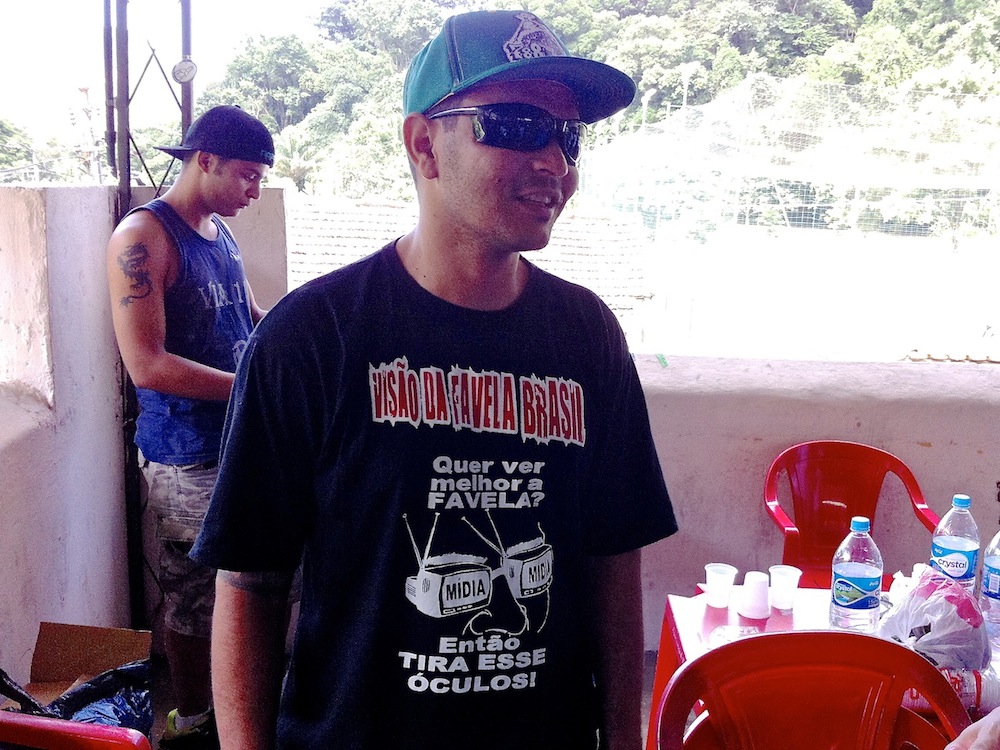 “Be aware that these issues have to do with which social class is allowed to live where,” said Constantine of Babilônia. “They took the vans out of the South Zone. All of the fares on the public buses are rising. But it is us who sustain society here,” referring both to favela culture and the jobs that favela residents perform in the city.
“Be aware that these issues have to do with which social class is allowed to live where,” said Constantine of Babilônia. “They took the vans out of the South Zone. All of the fares on the public buses are rising. But it is us who sustain society here,” referring both to favela culture and the jobs that favela residents perform in the city.
In the housing law language distributed by the Port Community Forum, the stipulation for on-site upgrading of favelas–where rather than dismantling functional communities by moving them to public housing, the missing public services are instead brought in–is explained as written into legal code in order to serve the “social function of land in Brazil,” that is, the function of accessible housing regardless of social class.
Francilene Cardoso, a resident of Chapéu Mangueira, said that it was important for favela residents to speak up not only about high charges, forced removals, and gentrification they were facing but also about the physical abuse of police force. “Part of this whole process is that more young people are getting shot and killed by the police,” she said, referring to tactics such as police fire into crowded residential areas. “You have a right to fair treatment by the police just like you have a right to housing.”
“We know what we need; we don’t need the government telling us,” said Constantine of increased policing and monumental interventions. “We need our right to housing to be respected. We need our dignity respected. And we need unity. Without popular participation, we’re not going to transform anything.”
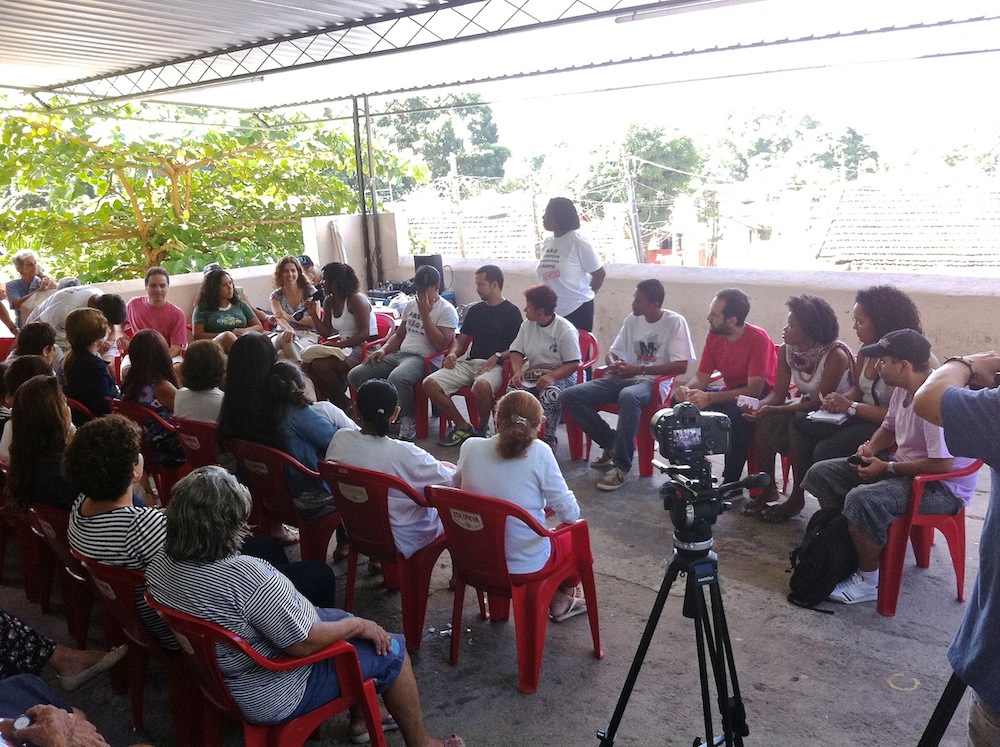 Public defender Adrianna Britto encouraged the group to participate as the surest method to a fair outcome. “You are citizens. You have a voice, and using it is the only way to reach justice,” she said to the crowd in Horto.
Public defender Adrianna Britto encouraged the group to participate as the surest method to a fair outcome. “You are citizens. You have a voice, and using it is the only way to reach justice,” she said to the crowd in Horto.
Both the Horto and Providência meetings included members of other social movements within the city, some of them non-favela residents. Monica Lima spoke against the widespread closing of public health facilities currently underway in the state and the privatization of healthcare plans encouraged by the government. Another attendee spoke about the importance of accepting allies to the Favela Não Se Cala movement who were not themselves favela residents but could offer support, whether that be in communications or technical assistance.
Constantine emphasized at both recent meetings that Favela Não Se Cala was a medium-to-long-term project of grassroots education. “We don’t want any affiliation with a political party, because the current system in Brazil is not a democracy,” he said in Providência. “I don’t have faith in it.” Instead, he encouraged communication as the surest method to mobilize people because it was a direct counter to the inconsistent information from the city government about coming changes in the lives of favela residents.
In particular, Constantine said it was important to communicate about the law and guidelines of the city and how they compare to current treatment. “People are telling me that I don’t have a right to live in my home,” said Socorro of Indiana-Tijuca. “I resist. I do.”
